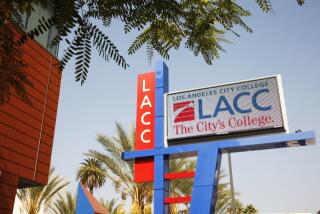Nonprofit website helps teachers buy classroom supplies
It has long been common practice for teachers to spring for a few items for their classrooms: a pack of highlighters, a ream of paper, art supplies for a class project.
But at a time of severe budget cuts, there are more materials than ever that schools just can’t provide. And sometimes, such items are relatively costly: a set of books, a sound system or an iPad.
As a result, teachers are turning increasingly to programs like the nonprofit website Donors Choose, which offers teachers a platform to make pleas for funding help for their classrooms.
“We don’t have all the resources we need for our students,” said Daniel Gettinger, who teaches Algebra II at Huntington Park High School. He has turned to Donors Choose to get graphing calculators and a document camera for his classroom. “I want to do everything I can to help my students achieve at every level.”
In Los Angeles, more teachers are likely to see their wish lists funded after a $4-million donation to Donors Choose this month by the Wasserman Foundation, an L.A.-based philanthropic organization. The money will be used for gift cards for Donors Choose that will be sent to the families of public school children, who then can use the cards to buy gifts for schools in Los Angeles, and to match donations from others in the community.
“It’s going to ensure that every household can be a microphilanthropist,” said Charles Best, a former teacher in the Bronx who founded the online program 11 years ago.
L.A. Unified has encouraged each teacher to post up to two projects, totaling $800, at DonorsChooseLA.org. So far, hundreds of teachers have made their pitches: a set of theater books for a middle school class; extra computers so that elementary students won’t have to wait too long for a turn; an iPad to replace a bulky, outdated computer at another elementary school; or a class trip to the Discovery Science Center to help fourth graders learn about electricity.
Patricia Miller, a transitional kindergarten teacher at Rosewood Avenue Elementary in Beverly Grove, uses wooden puzzles to help her students develop fine-motor skills and eye-hand coordination, but some had missing pieces. “I did not want to throw them away because I still considered it a valuable resource that I could not replace,” she said. Through the website, she was able to get new ones.
Best said the site was designed as a “showcase of teachers’ innovation and imagination.”
He said it also enables the community to invest in a school, while offering accountability. Teachers have to provide a detailed cost breakdown, and explain who their students are, what project they’re working on and what, exactly, the money will be used to fund.
Because of it, teachers have had to learn how to entice would-be donors to pick their projects over thousands of others on the website. Do they go for the pun or tug at the heartstrings? Be straightforward, or try to persuade donors that they could play a role in developing the greatest collection of minds since the Manhattan Project?
“You want to personalize it, to make sure they know who and where [the students] come from and know your project will improve student achievement,” Gettinger said of his strategy.
Others try different approaches. Some start with a funny headline (“Watt’s Up With Electricity?”) or try to sound empowering (“Emerging Writers Find Their Beat Within”). One teacher opted for the reality check: “My students are well aware that we are living in the digital era. So, why are they expected to learn in the same modalities that were used in the Victorian age?”
Some teachers have expressed concern that requests for help may make it seem as if they are seeking pity for poor students. “I don’t feel comfortable with that,” said Chuck Olynyk, a world history teacher at Roosevelt High School. “I won’t do it.”
But Best countered that it’s supposed to be a direct way for teachers to allow a community to invest in education. If anything, going the Dickensian route hinders their chances, he believes.
The ideal approach? “Let me tell you about my students, let me tell you about my project,” he said. “It’s not, ‘Please, sir, drop a penny in my tin cup.’”
More to Read
Sign up for Essential California
The most important California stories and recommendations in your inbox every morning.
You may occasionally receive promotional content from the Los Angeles Times.










